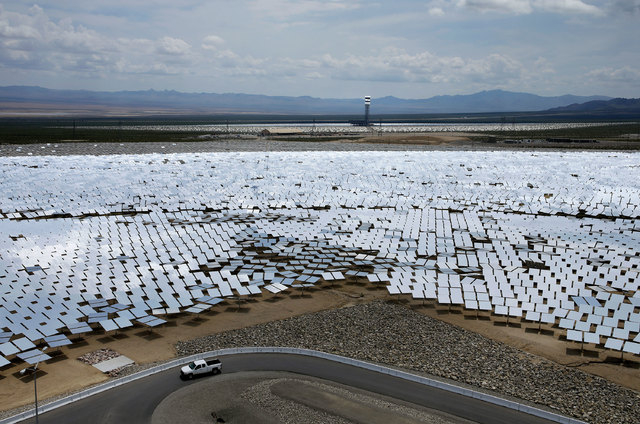Giant Ivanpah solar plant south of Las Vegas falls short


LOS ANGELES — The largest solar power plant of its type in the world — once promoted as a turning point in green energy — isn’t producing as much energy as planned.
One of the reasons is as basic as it gets: The sun isn’t shining as much as expected.
Sprawling across approximately 5 square miles of federal desert near the California-Nevada border south of Las Vegas, the Ivanpah Solar Electric Generating System opened in February, with operators saying it would produce enough electricity to power a city of 140,000 homes.
So far, however, the plant is producing about half of its expected annual output for 2014, according to calculations by the California Energy Commission.
It had been projected to produce its full capacity for eight hours a day, on average.
“Factors such as clouds, jet contrails and weather have had a greater impact on the plant than the owners anticipated,” the agency said in a statement.
It could take until 2018 for the plant, backed by $1.6 billion in federal loan guarantees, to hit its annual peak target, said NRG Energy Inc., which operates the plant and co-owns it with Google Inc. and BrightSource Energy.
“During startup, we have experienced … equipment challenges, typical with any new technology, combined with irregular weather patterns,” NRG spokesman Jeff Holland said in a statement. “We are confident that Ivanpah’s long-term generation projections will meet expectations.”
The technology used at Ivanpah is different from the familiar photovoltaic panels commonly used for rooftop solar installations.
The plant’s solar-thermal system — sometimes called concentrated-solar thermal — relies on nearly 350,000 computer-controlled mirrors at the site, each the size of a garage door.
The mirrors reflect sunlight to boilers atop 459-foot towers — each taller than the Statue of Liberty. The resulting steam drives turbines to create electricity.
When the $2.2 billion complex opened, Energy Secretary Ernest Moniz called it a “symbol of the exciting progress” in renewable energy.
Although the agency still says the project remains in good standing, Kaitlin Meese, an analyst at research firm Bentek Energy, said its early production figures “do not paint a strong picture for solar-thermal technology development.”
The operation of such plants is highly dependent on weather conditions, and predicting when and how strongly the sun will shine is not a perfect science.
A little bit of inefficiency with mirrors can translate into a loss of power output ranging from small to significant, said Neil Fromer, executive director of the Resnick Sustainability Institute at the California Institute of Technology.
Problems could include getting the thousands of mirrors pointed in precisely the right direction, especially in the cool early morning, or keeping them clean in the dusty Mojave Desert.
Operators initially expected to need steam from gas-powered boilers for an hour a day during startup. After operations began, they found they needed to keep boilers running more than four times longer — an average of 4½ hours a day.
State energy regulators in August approved the plant’s request to increase the natural gas it is allowed to burn by 60 percent.
Additional natural gas could also be needed to operate boilers when clouds thicken or to maintain output at the end of the day and extend the capability for power production, the company said.
“Because the plant requires sunlight to heat water and turn it to steam, anything that reduces the sunlight will affect steam conditions, which could damage equipment and potentially cause unsafe conditions,” said the commission, which approved the request for increased gas use.
Fromer said it was surprising that so much additional gas is needed, adding that it “signals to me they have some very large problems that they are going to need to sort out.”
Plants owners said they are learning on the fly to some extent.
“For some aspects of operation, the only way to fully understand how the systems work has been through the experience of operating,” plant owners wrote in the request to increase gas use.












